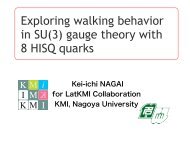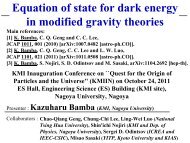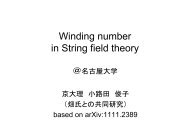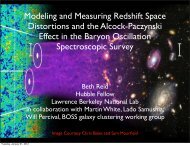Diego Saez-Gomez
Diego Saez-Gomez
Diego Saez-Gomez
Create successful ePaper yourself
Turn your PDF publications into a flip-book with our unique Google optimized e-Paper software.
3 Cosmological evolution in viable<br />
evolution<br />
f(R) gravity<br />
in viable<br />
In this Cosmological section, we explore evolution the cosmological in viable f(R) evolution gravity for the models considered above. For<br />
F(R)<br />
<br />
Inthat thisreason, section, itwe is convenient explore theto cosmological perform a change evolution of variables for the models in the equations considered(2.4), above. consid-<br />
For<br />
andscalar-tensor a 0 is the value equivalent, of the scale where factor the phase at thespace present willtime be explored. t 0 , such that the current epoch<br />
corresponds 3 Cosmological to z = 0 Then, evolution the time derivative in viableis f(R) transformed gravity as d dt = −(1 + z)H d dz<br />
, and the<br />
first FLRW equation in (2.4) and the continuity equation (2.7) yield,<br />
that<br />
In this<br />
reason,<br />
section, H<br />
it 2 (z)<br />
is<br />
we<br />
convenient<br />
= explore 1 <br />
κ 2 the ρ<br />
to m (z)+ cosmological R(z)f R − f<br />
perform a change<br />
evolution +<br />
of<br />
3(1<br />
variables<br />
for + z)H the 2 in<br />
models f RR<br />
the<br />
R equations<br />
(z) considered ,<br />
(2.4),<br />
above. (3.2) For<br />
ering the redshift z 3f as<br />
that reason, it is convenient R the independent variable 2 instead of the cosmological time t, wherethe considering<br />
to perform a change of variables in the equations (2.4), considering<br />
the<br />
redshift the redshift is defined z as the usual, independent variable instead of the cosmological time t, wherethe<br />
Using the redshift isas redshift<br />
defined the independent<br />
z<br />
as<br />
as<br />
usual,<br />
the (1 independent + variable: z)ρ m(z) −variable 3(1 + w m instead of the cosmological time t, wherethe<br />
redshift is defined as usual,<br />
1+z = a )ρ m (z) =0, (3.3)<br />
1+z = a 0<br />
1+z = a 0<br />
where now primes denote derivatives with respect to 0the a(t) ,<br />
a(t) , redshift. Then, the Ricci scalar can (3.1)<br />
be rewritten as R =6 2H 2 (z) − (1 + z)H(z)H (z) a(t) , (3.1)<br />
and a (3.1)<br />
0 is the value of the scale factor at the present , whiletime the equation t 0 , such that (3.3) the cancurrent be easily epoch<br />
solved and corresponds<br />
and<br />
for a 0<br />
a<br />
ais 0 is<br />
constant the to value z =<br />
the value<br />
EoS of 0 Then, the<br />
of the<br />
parameter scale the factor time<br />
scale factor<br />
w m , derivative the present is transformed time t 0 , such as d that the current epoch<br />
at the present time t 0 , such that the current epoch<br />
FLRW equations<br />
corresponds<br />
corresponds yield:<br />
to z = 0 Then, the time derivative is transformed as d dt = −(1 + z)H d<br />
dt<br />
to z = 0 Then, the time derivative is transformed as d = dt = −(1 −(1 + + z)H d dz<br />
, and the<br />
first FLRW equation in (2.4) and the continuity equation (2.7) yield,<br />
z)H dz d , and the<br />
first FLRW equation in (2.4) and ρ(z) the =ρcontinuity 0 (1 + z) 3(1+w equation m) . (2.7) yield,<br />
dz<br />
,(3.4)<br />
and the<br />
first FLRW equation in (2.4) and the continuity equation (2.7) yield,<br />
H 2 (z) = 1 <br />
κ 2 ρ m (z)+ R(z)f <br />
H 2 (z) = 1 <br />
κ 2 ρ m (z)+ R(z)f <br />
Here ρ 0 is the value<br />
H 2 (z)<br />
of the<br />
= 1 <br />
matter<br />
κ 2 ρ<br />
energy m (z)+ R(z)f <br />
R − f<br />
density R −atf<br />
the<br />
+ 3(1<br />
present<br />
+ z)H<br />
epoch 2 f RR R<br />
R − f + 3(1 + z)H 2 z <br />
3f + 3(1 + z)H 2 f RR R =<br />
(z)<br />
0,<br />
,<br />
which can<br />
(3.2)<br />
3f R 2<br />
f RR R (z) , (3.2)<br />
be rewritten as ρ 0 = 3 H<br />
κ 2 0 2 R 2<br />
(z) , (3.2)<br />
3f Ω0 m. Then, we can fit the current values of the cosmological<br />
parameters using the observational R (1 + data z)ρ m(z) 2<br />
(1 + z)ρ [28], −where 3(1 + wH m 0<br />
)ρ= m 100 (z) =0, hkms −1 Mpc −1 with h = (3.3)<br />
0.71 m(z)<br />
(1 + z)ρ − 3(1 + w m )ρ m (z) =0, (3.3)<br />
where ± 0.03now andprimes the matter denote density, derivatives Ω 0 m =0.27<br />
m(z) with − 3(1 respect ±<br />
+<br />
0.04,<br />
w m<br />
to)ρ while the m (z) redshift. the<br />
=0,<br />
matter Then, fluid theis Ricci considered scalar (3.3) can<br />
where pressureless the where last be rewritten equation now(cold primes can as dark R be denote matter =6 easily derivatives with respect to the redshift. Then, the Ricci scalar can<br />
be<br />
where<br />
rewritten<br />
now primes<br />
as R<br />
denote<br />
=6 2Hand solved,<br />
2 (z) baryons), − (1 + z)H(z)H such that (z) w <br />
derivatives with respect to the redshift. Then, Ricci scalar can<br />
be rewritten as R =6 2H 2 − (1 + z)H(z)H (z) m , = while 0. The the equation (3.2) (3.3) iscan a second be easily<br />
order solved differential for a constant equationEoS 2H 2 parameter H(z), so by w m<br />
fixing , the<br />
(z) − (1 + z)H(z)H (z) initial , whileconditions, the equation the(3.3) corresponding can be easily<br />
cosmological solved for evolution a constant can EoS beparameter obtained through w<br />
, while the equation (3.3) can be easily<br />
m , the Hubble parameter in terms of the redshift<br />
for solved both models for a constant considered EoSin parameter previous ρ(z) section, w m =ρ , 0 (1 and + z) explore 3(1+wm) how . the future evolution (with(3.4)<br />
−1










